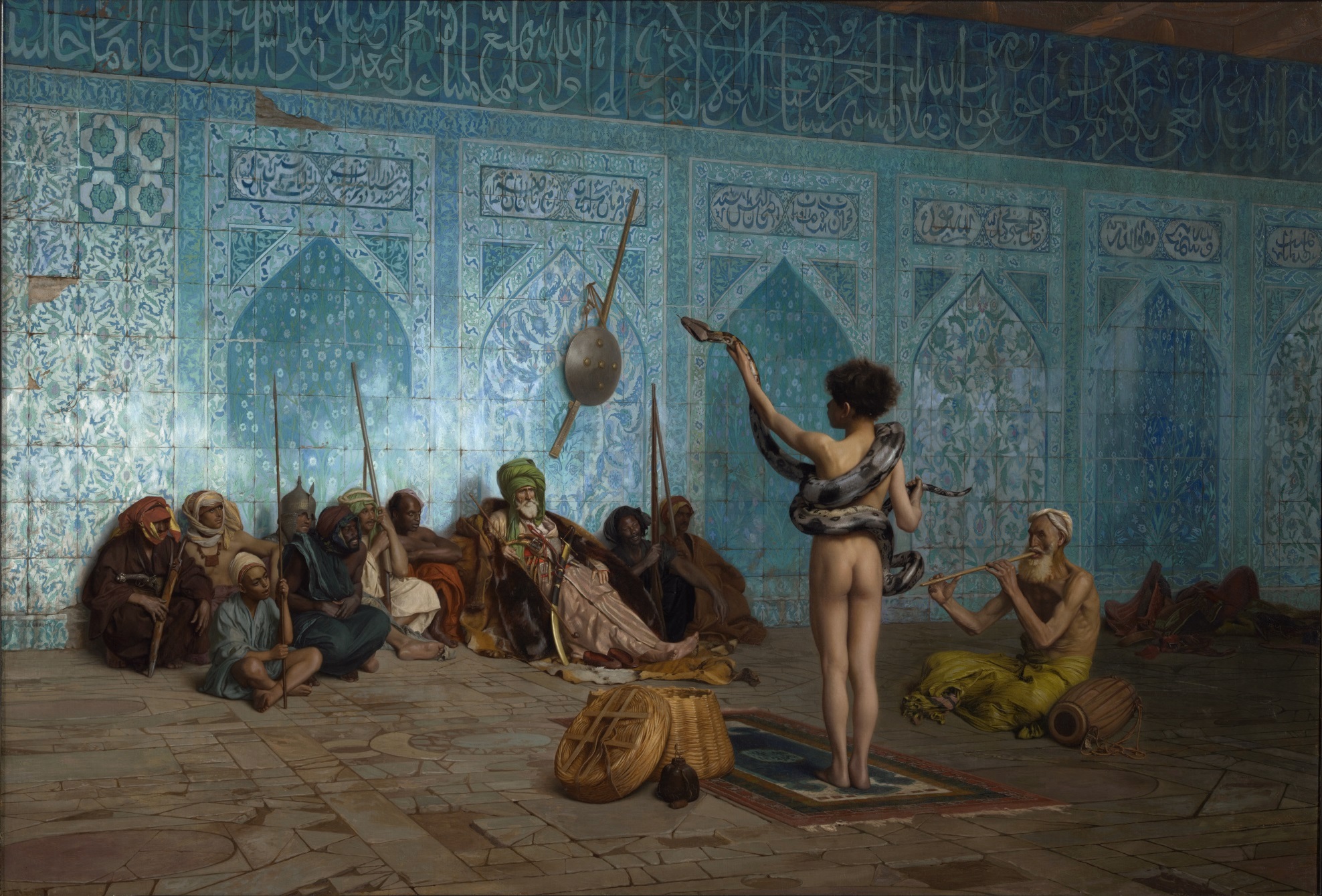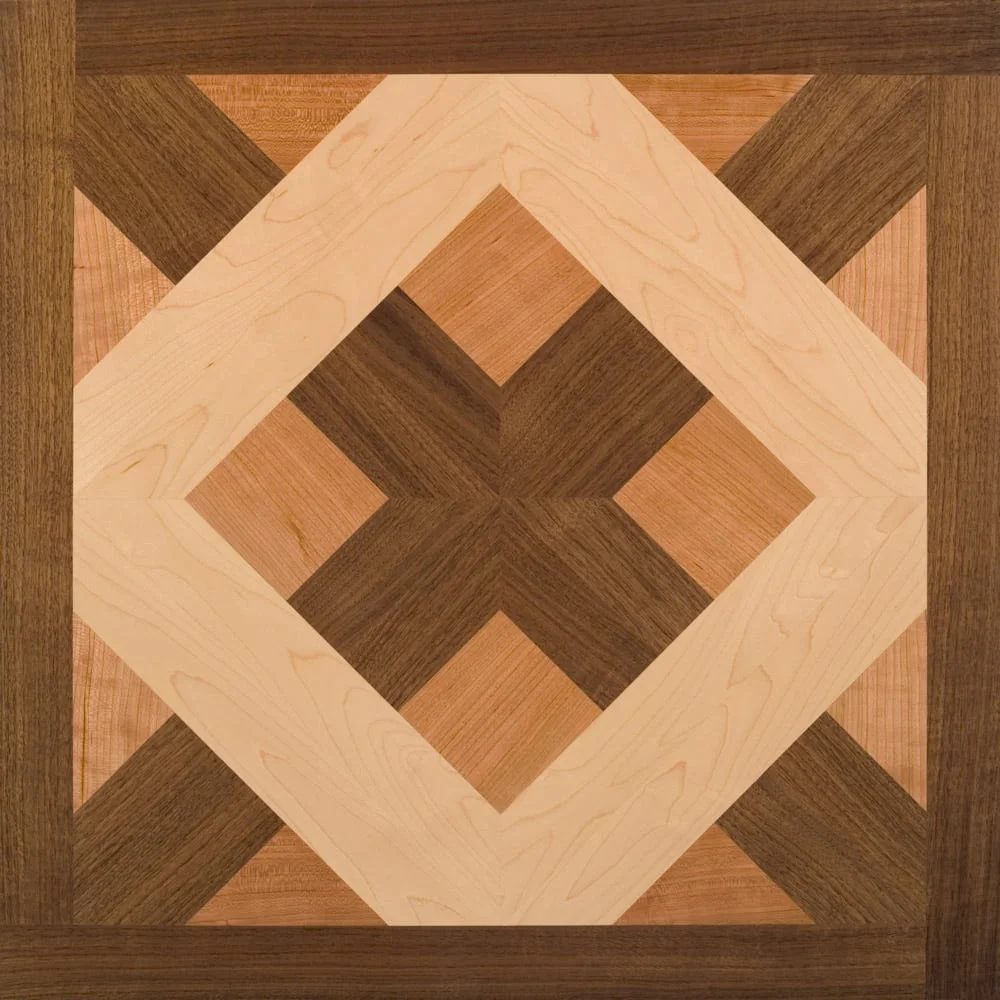Sahar's Snake
by Siena Oristaglio
What’s in a voice?
I’m seated in a small white gallery space.
An artist, Sahar Sepahdari, stands at the front
of the room. The artist wears a blue metallic mask.
A projection screen at the front of the room displays
two figures clothed in loose, bright fabrics.
One plays an instrument. The other crouches,
half-kneeling, arms bent outwards.
The figures appear to be dancing.
A caption beneath the image reads,
“Woven Tapestry. Shajar Dynasty. 18th Century.
Pragmatic Weaving.”
Sepahdari holds a microphone up to the mask.
“Hello,” they say.
The artist’s voice is auto-tuned;
it booms robotically through the space.
The room lets out a laugh.
The sound is surprising. Strange.
Sepahdari continues in mechanical staccato:
“This is a lecture on Iranian women —
figures, really —
in art.”
They introduce the tapestry on the screen
and begin to discuss the work with a blend of
historicism and lyricism.
“Here, we see a doubling that feels like it
is subverting a kind of gender fluidity,”
they state.
“The figures look a lot like me.
Most Iranians look many ways in
many years of time.”
The mirrored mask shimmers,
reflecting the faces of those gathered in
the room. The projection of the tapestry
casts a gold-ish glow.
Studying the artist and the screen,
I’m struck by how unusual it feels to
witness a presentation delivered by
someone in a mask with a robotic voice.
Powerpoint presentations: an arena often
dominated by white men in business suits
explaining pie charts to conference tables
full of white men in business suits.
Silent nods. Furrowed eyebrows. Notes taken.
A staccato of deep voices, conferring
singularity of purpose.
Assignments given, minutes emailed.
Chatter in a blue-tiled men’s bathroom
after the meeting. A plan for beers later.
A return to desks.
“These women are strong –
sisters in the crime of poetry and labor,”
Sepahdari asserts, pointing at the tapestry.
I witness as the space in front of the
projection screen is transformed, lifted,
made non-binary, non-white, non-man, masked.
The artist’s voice vibrates.
Each sentence is inviting and alienating.
Funny and serious. Warm and cold.
Both. Neither.
I notice my arms and legs are covered
with goosebumps.
I lean forward in my seat.
“Next slide,” the artist says.
.
“Jean-Léon Gérôme, The Snake Charmer, c. 1879, Oil on canvas. (Sterling Francine Clark Art Institute, Williamstown, Massachusetts.)”
Whose stories are predatory? Whose are swallowed?
A new image fills the screen.
Sepahdari reads its caption.
“Jean-Léon Gérôme, The Snake Charmer, c. 1879,
Oil on canvas. (Sterling Francine Clark Art Institute,
Williamstown, Massachusetts.)”
The syllables hang in the space.
Below the painting is a screenshot of an article
from The Daily Star online newspaper.
Its headline: “Islam’s ‘third holiest mosque’
burns on the SAME night as Notre Dame.”
The artist speaks about these two images,
first describing the painting.
They note the dark grey snake wrapped
around the arm of a young child.
“The boy stands erect on a small raised carpet,”
they note.
“Almost everyone is a darker complexion than the boy.”
they note.
“There are no women present,”
they note.
“His skin is centered as if a highlight — a spotlight.”
I catch an audience member nodding
in the reflection of the mask.
I stare at the skin of the child figure, then at the
seated figure who plays an instrument.
I study the snake wrapped around the child’s body.
The snake’s head is bent. It extends outwards.
The snake appears to be dancing.
I’ve seen this painting before.
I try to remember what I know about it.
I recall that Gérôme was a French artist who never
traveled to many of the places he depicted.
I recall that this painting is an example of a colonialist
fantasy of the “east” created entirely from the
imagination of a “western” artist. The painting is
rendered photo-realistically as if it depicts an accurate
representation of a scene the artist witnessed when,
in fact, it’s a pure fiction, pure colonial fabrication.
Sepahdari asks a question about the child holding the snake:
“Could this figure be a non-binary representation of
my inner art historian child?”
The question, in autotune, sounds
less like a question and more like a statement,
the artist a machine reciting from a digital database.
“Could it be that I refuse to identify at all?”
I recall, years ago, stumbling across an article about
two-headed snakes and discovering that these creatures
were not mythical but rather an actual occurrence in nature.
I learned that even when both heads of a two-headed snake
are well-fed, they tend to combat one another.
Neither recognizes that the other is part of the same creature.
Frequently, the more predatory head attacks and kills the
other, causing both to die. This is classified by some
herpetologists as homocide-suicide event.
I imagine the news of Notre Dame burning as one head of
a snake swallowing the other: news of the Al-Aqsa mosque
burning that same night. I imagine Gérôme’s colonial fantasies
violently engulfing the reality of the places he depicts.
“Next slide,”
the artist announces.
The audience laughs again, broken from the trance
of poetic analysis.
The auto-tune is still funny.
The artist turns to introduce a new image on the screen.
.
What can we learn from a fixed gaze? From a moving heart?
An image of the artist Shirin Neshat now suspends above the room.
Neshat points a gun directly outwards.
Her face is covered in calligraphic Farsi poetry and text.
“I am reminded of these originals
works that gave me power.”
Sepahdari explains.
“She holds a pistol at you,
she holds your gaze,
she is an Atheist
and she will be exiled for this work.”
I fix my gaze on the image. My heart races in my chest.
I recall that snake hearts are known to move around
their bodies. They can do so because snakes have no
diaphragm, a fact which protects their hearts
from damage when they eat large prey.
I become aware of my diaphragm and ribcage,
securing my beating heart in place.
“Will she suck up her seducer or seduce you?”
the artist asks.
I envision how snakes consume their prey:
toothlessly, swallowed whole.
“Can you see her?”
Sepahdari points at the projection.
“Are you looking?”
the artist asks.
“Keep seeing her.
Keep looking.”
Minutes later, the presentation is over.
The artist removes the mask.
The screen goes dark.
My heart slows.
.
What are snakes afraid of?
I exit the gallery and walk down a dimly lit street.
I’m alone.
My mind flashes to the reflective sheen of Sepahdari’s mask,
the hypnotic quality of their digitized voice.
I think of the figure in the center of the Gérôme painting,
the snake wrapped around the child’s waist: once, twice.
I think of how easy it would be for that snake to crush
the child’s small frame, yet it stays transfixed, trained
to dance for the crowd. I recall my close friend’s
fear of snakes, my partner’s fear of snakes.
I imagine the people throughout history
who have feared their sliver, their hiss, their rattle,
their venom, their bite, their coil, their squeeze.
Their forked tongues, refusing singularity.
What are snakes afraid of? I wonder.
I search the question on my phone and find answers.
“Snakes fear anything large that thumps on the
ground when it walks,” a geographer writes.
“Snakes fear almost everything more than one inch tall,”
a former zoo-keeper answers.
As I read, I rattle down the street and
approach a fork in the road.
Reaching the fork, I look up.
A large building looms ahead of me
between the two streets.
In this moment, I am one-inch tall.
I inhale deeply.
My diaphragm disappears and
my heart sinks into my stomach.
I slide straight through the building,
hissing.
Siena Oristaglio (all pronouns) is an artist and educator. She co-runs The Void Academy, an organization that helps independent artists thrive. She lives in New York City.






